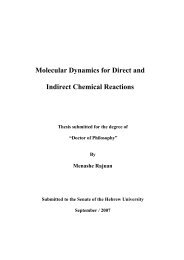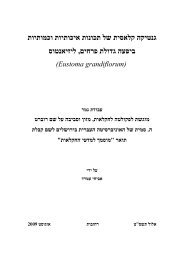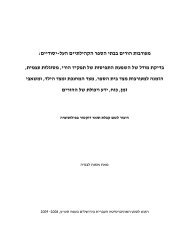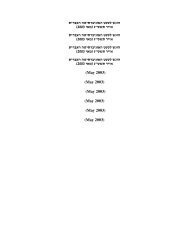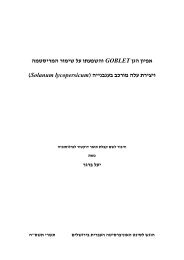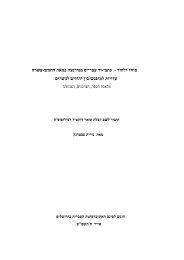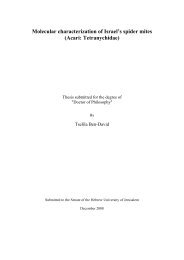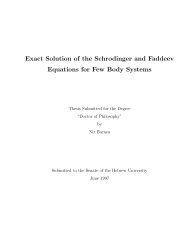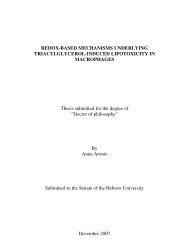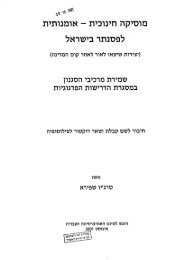Revealing the Mechanism of HSP104 Transcription Initiation in the ...
Revealing the Mechanism of HSP104 Transcription Initiation in the ...
Revealing the Mechanism of HSP104 Transcription Initiation in the ...
You also want an ePaper? Increase the reach of your titles
YUMPU automatically turns print PDFs into web optimized ePapers that Google loves.
is responsible for deacetylat<strong>in</strong>g histone H4 it will be necessary to construct many<br />
stra<strong>in</strong>s with comb<strong>in</strong>ed deletions <strong>of</strong> various HDACs. Many transcriptional activators,<br />
such as Hsf1 (<strong>in</strong> mammals), Gcn4 and Swi5 have been shown to recruit chromat<strong>in</strong><br />
remodel<strong>in</strong>g complexes to promoters <strong>in</strong> vitro and <strong>in</strong> vivo (29, 124). Does Hsf1 <strong>in</strong> yeast<br />
play such a role on heat shock <strong>in</strong>duced promoters? As Hsf1 constitutively b<strong>in</strong>ds<br />
<strong>HSP104</strong> regardless <strong>of</strong> stress conditions, perhaps some post-translational modification<br />
<strong>of</strong> <strong>the</strong> prote<strong>in</strong> could target chromat<strong>in</strong> modify<strong>in</strong>g complexes to <strong>the</strong> <strong>HSP104</strong> promoter.<br />
An alternative explanation is that Msn2/4 recruit <strong>the</strong> nucleosome remodel<strong>in</strong>g<br />
enzymes. The fact that <strong>the</strong> lower levels <strong>of</strong> acetylated H3 or H4 are found <strong>in</strong> ras2∆, <strong>in</strong><br />
which Msn2/4 are constitutively active and probably constitutively bound, supports<br />
<strong>the</strong> notion that Msn2/4 are responsible for <strong>the</strong>se changes.<br />
Studies show that <strong>in</strong> Drosophila, Hsf1 is responsible for recruit<strong>in</strong>g <strong>the</strong><br />
mediator complex to heat shock promoters (95). Hsf1 <strong>in</strong> S.cerevisiae was also shown<br />
to have a role <strong>in</strong> recruit<strong>in</strong>g <strong>the</strong> SRB/MED co-activator complex to Hsf1 dependent<br />
promoters (39). Hsf1 may recruit <strong>the</strong> SRB/MED complex to <strong>the</strong> <strong>HSP104</strong> s<strong>in</strong>ce we<br />
f<strong>in</strong>d that SRB/MED is <strong>in</strong>volved <strong>in</strong> transcription <strong>in</strong>itiation <strong>of</strong> <strong>HSP104</strong>. The<br />
confirmation <strong>of</strong> such a hypo<strong>the</strong>sis could be achieved by perform<strong>in</strong>g a successive<br />
immunoprecipitation followed by PCR (i.e., double ChIP assays, one<br />
immunoprecipitation aga<strong>in</strong>st Hsf1 followed by ano<strong>the</strong>r one aga<strong>in</strong>st a component <strong>of</strong><br />
<strong>the</strong> SRB/MED complex) as components <strong>of</strong> <strong>the</strong> mediator complex have been shown to<br />
be associated with <strong>the</strong> <strong>HSP104</strong> promoter <strong>in</strong> response to heat shock and to o<strong>the</strong>r Hsf1<br />
target genes (39). The Srb10 component <strong>of</strong> <strong>the</strong> SRB/MED complex seems to be<br />
<strong>in</strong>volved <strong>in</strong> transcription <strong>of</strong> <strong>HSP104</strong> (Table 4). We observed that at <strong>the</strong> level <strong>of</strong> <strong>the</strong><br />
reporter gene activity and, more importantly, at <strong>the</strong> level <strong>of</strong> RNA production.<br />
However, our reporter studies demonstrated that <strong>the</strong> activity <strong>of</strong> a STRE-LacZ reporter<br />
<strong>in</strong> srb10∆ was significantly up-regulated even under non-heat shock conditions. This<br />
result is <strong>in</strong> agreement with studies show<strong>in</strong>g that Msn2 is degraded <strong>in</strong> a Srb10-<br />
dependent manner (39). Regard<strong>in</strong>g <strong>HSP104</strong> transcription, this suggests that o<strong>the</strong>r<br />
mechanisms seem to override <strong>the</strong> loss <strong>of</strong> Srb10 and that probably Srb10 <strong>in</strong> <strong>the</strong> context<br />
<strong>of</strong> <strong>the</strong> SRB/MED complex has ano<strong>the</strong>r function.<br />
Through <strong>the</strong> genetic screen, we also found that Rpb4, a RNA PolII subunit, is<br />
required for <strong>HSP104</strong> as well as for HSP26 and SSA3 transcription [Figs. 14 and 15<br />
and (24)]. Indeed, DNA micro array studies show that 98% <strong>of</strong> genes are<br />
downregulated <strong>in</strong> response to heat shock <strong>in</strong> RPB4 null cells (89). Interest<strong>in</strong>gly and<br />
51



